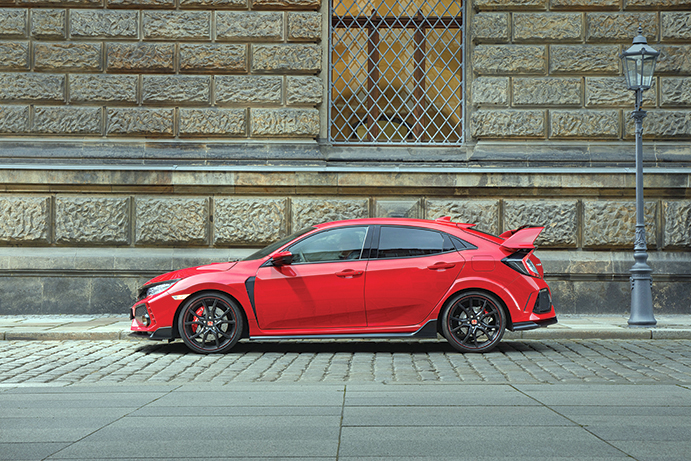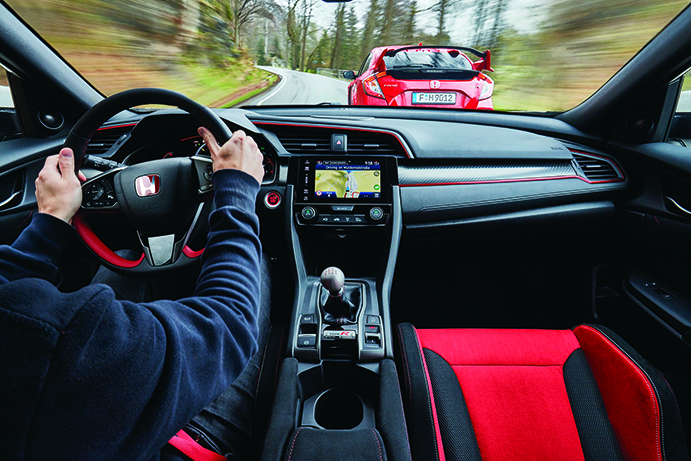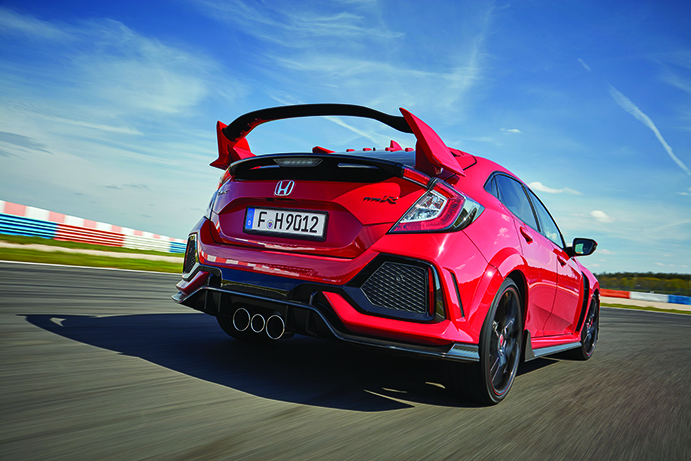Chris Pickering gets to grips with the Honda Civic Type R, the fastest front-wheel-drive production car to lap the fearsome Nürburgring Nordschleife
Decked out with more vents and spoilers than a Friday night in a McDonald’s drive-through , the new Honda Civic Type R could never be accused of hiding its light under a bushel. But what you see here is the real deal. It’s the fastest front-wheel-drive production car ever to lap the fearsome Nürburgring Nordschleife. Find a long enough straight and it will crack the best part of 170mph.
Under the bonnet there’s a two-litre turbocharged four-cylinder petrol engine, producing 320PS (316bhp) and 400Nm of torque. It’s a relatively mild revision of the engine found in the previous generation Honda Civic Type R, which courted controversy somewhat among Honda fans by abandoning the brand’s traditional high-revving naturally aspirated format in favour of forced induction.

Two years down the line, things have moved on. The idea of a turbocharged Honda no longer raises any eyebrows and neither does the firm’s decision to put all that power through the front wheels. While an increasing number of hot hatches are now turning to four-wheel drive, Honda points out that a front-wheel drive set-up is both lighter and more efficient.
The chassis is based on the regular 10th-generation Civic, which uses an innovative ‘inside-out’ assembly process. Here, the inner frame is assembled first, followed by the outer frame and then the joints. The resulting structure is 16kg lighter than the previous Honda Civic Type R’s, despite being both longer and wider. It also yields a torsional stiffness improvement of 37 per cent and a static bending rigidity improvement of 45 per cent.
As with the previous model, all Civic Type Rs – even those bound for export to Japan – are produced by Honda UK Manufacturing in Swindon. For the international launch, however, we headed slightly further afield, to the de-restricted Autobahns of Germany.
Traffic prevented a proper attempt at the claimed 169mph top speed, but the Type R was still pulling determinedly at an indicated 156mph. More importantly, it felt absolutely rock solid at that speed. All those aerodynamic accoutrements, it turns out, are there for more than just show. In fact, Honda claims this is the only car in its class — and one of relatively few road cars full stop — to produce genuine downforce, as opposed to simply negating lift.
Accelerate hard from low revs and you can sense the engine building up boost, but there’s no real lag. That’s thanks, in part, to the use of variable valve timing and lift on both the camshafts, which enables very careful control of the exhaust back pressure. The throttle response is pin sharp, aided by a single-mass flywheel, which reduces the clutch inertia by some 25 per cent over the outgoing model.

It all adds up to a hugely fast car. The mighty mid-range torque is accompanied by a genuine appetite for revs. Before you know it, the engine is lunging for the 7,000rpm limiter and it’s time to grab another gear. If anything, Honda’s claim of 0-to-62mph in 5.7 seconds feels a little conservative.
Following the blast down the Autobahn we headed to the Lausitzring to sample the car on track. Grip is prodigious, as you might expect, but what really impressed was how well the Type R manages to blend agility and composure.
At 1,380kg, it’s a relatively light car by modern standards, and it slices through the direction changes with scalpel-like precision. The variable-ratio electrically assisted power steering also helps. It isn’t the most communicative system, but it does feel remarkably intuitive; the only clue to its non-linear nature is the fact you can negotiate the tightest of turns without shuffling your hands around the wheel.
Honda’s decision to stick with front-wheel drive has been well and truly vindicated. Those of a hooligan persuasion might argue that driving the rear wheels can be more fun, but at no point
did the Type R’s chassis feel overwhelmed by its power. Torque steer is almost completely absent, thanks to the dual-axis front suspension concept carried over from the previous model. This puts the wheel carrier on a separate knuckle to the main MacPherson strut, placing the steering axis much closer to the centreline of the wheel. There’s also a proper mechanical limited-slip differential, aided by an electronic system that can selectively apply the brake on either side to quell any wheel spin. It works brilliantly, although it’s not as addictive as the ultra-aggressive differential on the previous model.

Away from the track, the biggest strides forward are actually to be found in the more everyday aspects of the car. The previous Honda Civic Type R was a real hardcore headbanger. It was great for track-day enthusiasts, but the ride was simply too stiff for UK roads in its most aggressive setting. For the new car, Honda has stuck with magnetorheological dampers, but switched to a triple-chamber design, which provides a much wider range of adjustment. It feels positively plush in comparison and should help to significantly broaden the car’s appeal.
The acoustics have also been carefully optimised to make the new Honda Civic Type R substantially quieter while cruising. Uniquely, it features an additional tailpipe in what is essentially a twin-exit exhaust system. At high flow rates, this third pipe acts as an additional exhaust outlet, giving the engine a deeper growl. But at lower gas velocities, the flow reverses, sucking in ambient air to prevent the booming noise that would otherwise fill the cabin. The resulting soundtrack isn’t the most symphonic, but it is suitably purposeful.
The end result is a car that retains most of the previous Type R’s razor-sharp focus, while offering a far more useable day-to-day proposition.




Red Bull makes hydrogen fuel cell play with AVL
Formula 1 is an anachronistic anomaly where its only cutting edge is in engine development. The rules prohibit any real innovation and there would be...